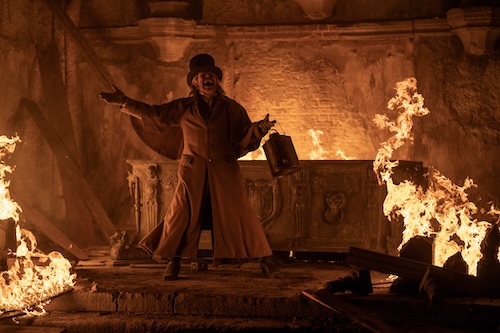
Nosferatu promises to deliver a feast of full-blooded horror when it's released in January 2025. It's the latest film from noted genre director Robert Eggers and comes as a remake of the 1922 German Expressionist masterpiece helmed by F.W. Murnau and starring Max Shreck in the title role. It was also remade by Werner Herzog in 1979, starring Klaus Kinski as Nosferatu.
Eggers' film tells the story of Anne Hutter (Lily-Rose Depp) who discovers that her long-held nightmares of demonic possession are about to become a horrible reality. Enter the monstrous vampire Count Orlok (Bill Skarsgard) who, having become infatuated with Anne's image, has taken up residence in her local town, in the process bringing plague-ridden havoc on the local population.
The character of Nosferatu (a Romanian term synonymous with 'vampire') has endured as a bone-chilling image of horror cinema for nearly a century, and Eggers' take on the material promises to be a spine-tingling classic in its own right. Here's why he's the perfect person for the material.
1. He directed a stage adaptation of Nosferatu when he was younger
It's true – in 2001, years before he became a celebrated horror filmmaker in his own right, Eggers directed an amateur take on Nosferatu. Here are some shots.
Robert Eggers directed a stage play of Nosferatu in 2001, here are some pictures. #Nosferatu pic.twitter.com/2hkLokQ136
— EggersFilms (@EggersFilms) June 27, 2024
Eggers has been passionate about Nosferatu for much of his life, which makes him the ideal person to helm a blood-curdling new adaptation. He's always enjoyed walking on the dark side, in particular the Universal Monsters classics from the 1930s and 1940s that transformed feared beasts and demons into enduring pop culture icons.
“I was always interested in dark stuff," Eggers tells AnOtherMagazine. "I preferred Darth Vader to Luke Skywalker and the Wicked Witch of the West to Dorothy, but the witch scared the absolute s**t out of me. I had nightmares about her all the time.
"So what is this attraction-repulsion? Universal films aren’t about the jumpscare, they’re about atmosphere. To probe the dark within us in a real way, to go back to those childhood instincts with a more adult approach, that’s my intention. How do you create the post-expressionist atmosphere of the Universal horror movies in a more grounded, realistic way and make the monsters believable?”
2. Eggers' films demonstrate a mastery of Gothic atmosphere
Eggers burst onto the scene in 2016 with his feature film debut, The Witch. It brought the house down at the Sundance Film Festival, praised for its slow-burn atmosphere of mounting terror and avoidance of crass, predictable jump scares. Effectively cast (Anya Taylor-Joy was propelled to stardom) with an almost fanatical attention to detail in the colloquial, 17th-century period dialogue, The Witch was hailed as one of the finest psychological thrillers in years.
Emboldened by the film's success, Eggers went even further out there with his 2020 follow-up film, The Lighthouse. Mixing elements of H.P. Lovecraft with Coleridge's Rime of the Ancient Mariner and more than a dash of Steptoe & Son, it was an intense, blackly comic affair. Ironically, the film's claustrophobic atmosphere seemed to anticipate the COVID-19 lockdown conditions that gripped the world just a few months after its release.
Eggers' most recent film was The Northman (2022), which saw him branch out from Gothic horror into Viking lore. That said, it's likely Eggers' most horrific movie to date, a retelling of the Amleth Viking legend that itself inspired William Shakespeare's Hamlet. Although it isn't a horror movie in the traditional sense, The Northman's unflinchingly visceral depiction of Viking conquest left audiences shaken.
All of Eggers' films demonstrate a keen love of menacing atmosphere, a well-honed shock factor and a marvellous ability to immerse audiences in period contexts where all manner of horror, be it psychological or physical, has the potential to emerge from the shadows and create chilling chaos. This is exactly what we'd expect from a new Nosferatu adaptation and critics say the film delivers in spades. (Discover the Nosferatu early responses.)
Nosferatu is the apex of this lusciously moody style. Eggers works with his regular cinematographer Jarin Blaschke to communicate a symphony of light and shade that acts as a loving homage to German Expressionist cinema. This was a movement that prized itself on stylised, intentionally artificial contrasts between light and dark, and very often shadows were painted onto the floor of film sets for added dramatic effect (1920's The Cabinet of Doctor Caligari used this approach).
One need only look at the final shot of the Nosferatu trailer, in which Nosferatu is silhouetted behind a billowing curtain, to be reminded of Eggers' skill at capturing terrifying big-screen imagery.
3. He knows how to get memorable performances out of actors
Horror only works if the audience is emotionally committed to the concept. This is where actors come in, but actors can only soar if trust the filmmaker in charge. Eggers elicited fine performances from Anya Taylor-Joy, Ralph Ineson and Kate Dickie in The Witch, all of whom were fiercely convincing as a puritanical family torn asunder by demonic activity.
Taylor-Joy, in particular, was superb as the family's eldest daughter, Thomasin. As a young girl on the cusp of adolescence, Thomasin is the lightning rod for all that ails her family, and she eventually becomes a pariah until, in a horribly ironic twist of fate, she appears to find kindred spirits in the form of a witches coven lurking in the nearby woods.
The combination of strong writing, direction and performance helps transfigure a potentially throwaway chiller into something much deeper that pierces notions of gender roles and sexuality amid modern America's tortured, colonial birth. Both Taylor-Joy and Ineson have become Eggers regulars, the former appearing in The Northman and the latter in Nosferatu.
The Lighthouse maybe isn't as affecting but it's a much more brutal sensory experience that is galvanised by the performances from Robert Pattinson and Willem Dafoe (another member of the Eggers repertory company, having also appeared in The Northman and with a role in Nosferatu yet to come). They play opposing lighthouse keepers on the warpath amid suggestions of supernatural enchantment, which is further aggravated by emotional isolation, loneliness and sexual frustration.
Dafoe's Captain Birdseye-gone-to-seed performance, all resonant consonants and briny tall tales, is well-matched by the escalatingly impressive Pattinson, here playing an angry, insular young man with plenty of secrets up his sleeve. Their explosive chemistry, which spills over from mutual distrust into rampaging hatred, is as horrific as it is hilarious.
The Northman may have been longer on Norse bellowing than actorly introspection, but Alexander Skarsgard is a fearsome beast of a man in the central role of Amleth. The film's standout performance, however, comes from Nicole Kidman as Amlet's gimlet-eyed mother. Her climactic scene, which transfigures the entire story, is a fine example of psychological manipulation and gaslighting that makes us re-evaluate everything we've already seen.
Nosferatu promises the same level of commitment to performance. In collaboration with Eggers, actor Bill Skarsgard, who plays the eponymous Count Orlok, lost a significant amount of weight and worked with an opera coach to lower his voice several octaves. All the better to communicate a sense of profound evil that resonates from beyond the grave.
4. His commitment to skin-crawling detail is legendary
Horror works best when it is tactile and palpable. One need only think of the body horror extravaganzas of David Cronenberg (The Fly) or John Carpenter (The Thing), which used oozy, tactile latex constructions to immerse us in uncomfortable scenarios. Recently, director Coralie Fargeat maintained this tradition with her acclaimed Demi Moore-starring horror, The Substance.
For Eggers, it goes beyond mere shock value. He's deeply committed to making audiences believe in arcane, ancient landscapes and traditions. When it came to scripting The Witch, Eggers derived much of his written material from real-life, first-hand accounts of 17th-century colonialists, ensuring that the dialogue spoken by the actors would be more than an ersatz imitation of the period.
When it came to filming The Lighthouse, Eggers and his crew constructed a 70-foot set off the coast of Nova Scotia amid harsh conditions, simply because they couldn't find an existing structure that fitted the story. The production of The Northman became infamous for the toll it took on Skarsgard and the rest of the actors, demanding long, complex takes through mud and Irish rain to convey a physical sense of realism.
It's safe to say that Eggers's productions are no mere walk in the park, something the director has admitted himself with rueful irony. Nosferatu is no different: one scene involved Willem Dafoe, playing Professor Albin Eberhart Von Franz, and some 5,000 live rats, a decision that led to complications.
"There's 5,000 real rats. So basically, if there's rats in the foreground, they're real, and they thin out and become CG rats in the background," Eggers explained (via Games Radar) during a Q&A that followed an exclusive screening of the film in Los Angeles, hosted by Guillermo del Toro. "And they were well-trained – like when the rats like run off of the ship, they were on buzzers. And the rats that were on Emma Corrin... I didn't know that rats are incontinent. And so the smell is insane."
5. He knows how to use sound and music to its fullest extent
The Witch wove a fine tapestry of susurrant sound and devilish instrumental effects from composer Mark Korven. The creaking of the boughs in the forest seems to emanate a sense of arcane evil while Korven's music supplies more immediacy, alerting us to the menace that is encircling the family at the heart of the drama. One need only think of the chorale and dissonant strings that mix when Harvey Scimshaw's unsuspecting son approaches the witch's den and is seduced by pure evil.
Korven's music was also at the forefront in The Lighthouse, skittering and keening and communicating a disharmonious atmosphere that spoke of the central human tension at the heart of the story. That said, the most memorable music in the film came from the titular structure's blaring foghorn, which becomes an omen of impending catastrophe that punctuates every meltdown between Dafoe and Pattinson's characters.
The Witch and The Lighthouse are fascinating studies of opposites. Whereas the former is a quiet film that builds to a shrieking climax, The Lighthouse is operatic from the off, augmented by the incessant sound of crashing waves and spray.
The Northman owes more to the aural sensibilities of The Lighthouse, resonating with roaring, guttural cries, clanging weaponry and a booming, brass-heavy soundtrack by Robin Carolan and Sebastian Gainsborough.
Carolan is back to score The Northman and you can hear one of the cues below. It's appropriately long-lined and moody in its approach, conveying both a sense of melancholic ennui and brooding horror, which is entirely appropriate for a story about beauty being stalked by the beast. It's yet more confirmation of the artistry that courses through the films of Robert Eggers.
Succumb to the darkness when Nosferatu is released on January 1st, 2025.
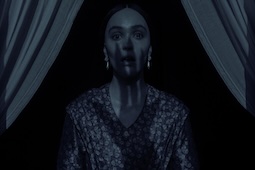
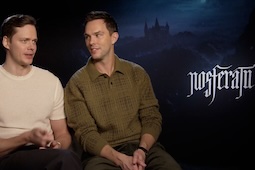

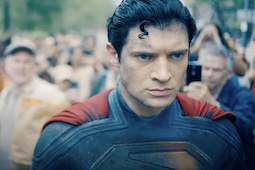
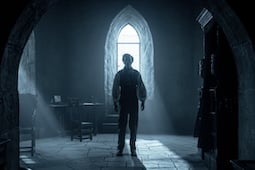
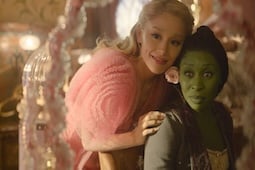






.jpg)
.png)






